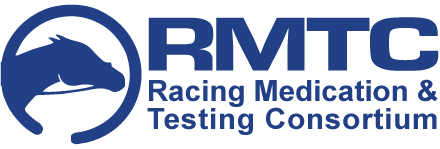Frequently Asked Questions
GENERAL
independent voice for uniform rules, policies, and testing standards through research based
recommendations. The goal of these recommendations is to ensure the integrity of horseracing and
protection of the welfare of horses and other participants.
Its 23 member organizations represent horsemen’s groups, breed registries, racetracks, racing regulators,
industry associations and veterinarians. To see all of RMTC’s member organizations, please visit the Who We Are section of our homepage.
The SAC identifies tactical research needs, develops medication control strategies, solicits and monitors research projects, reviews data and formulates recommendations for regulatory thresholds and corresponding withdrawal guidance. The SAC also supports the development of new or improved testing methods, the sharing of laboratory information, and conducts workshops for chemists in the application of analytical methods.
1. A Schedule of Controlled Therapeutic Substances (CTS);
2. Third-party Lasix administration;
3. A Multiple Medication Violation (MMV) program; and
4. RMTC Laboratory Accreditation.
Each portion of the NUMP was initially developed through subcommittees of the RMTC. The goal was to develop a comprehensive uniform program for the regulation of medications in horseracing. Each portion of the NUMP was approved by the RMTC Board and the Association of Racing Commissioners International (RCI). Each of these provisions is being used in numerous racing jurisdictions across the country. The goal is uniform implementation of all four aspects of the program in every racing state nationwide.
CTS
While the list is not inclusive of all potential medications that can be used in a horse, every effort was made to provide representative medications necessary to treat the common ailments of horses in training. Subsequent to the development of the initial list, additional medications have been added at the request of both the USTA and AAEP veterinarians. Furthermore, the RMTC has a formal process for considering additional medications for inclusion on the CTS list as new medications become available or as research funding becomes available.
A copy of the CTS list is available at: Controlled Therapeutic Substances May 2020
For non-historical thresholds, RMTC then used that data and applied a 95/95 tolerance interval calculation to the data. The 95/95 tolerance interval is a robust statistical analysis used by the European Agency for the Evaluation of Medicinal Products. It accounts for the variability of the data as well as the number of horses used in the study. A full explanation of the analysis can be found here.
Furthermore, the experiments performed to set these thresholds do have limitations. The experiments were performed using a specific dose of each medication and did not account for concurrent administration of other medications or other substances – which could affect the length of time required for the medication or its metabolite to fall below the regulatory threshold. Trainers and veterinarians are encouraged to perform their own risk assessment based upon the characteristics of the medication, its rate of clearance, and the dose and route of administration as well as the treatment of the horse with other substances. The use of compounded medications can also cause unintentional overages – even if the recommended dose is used based on label concentration – because in some cases compounded medications do not contain the label concentration of the active ingredient.
The RMTC withdrawal recommendations use the best information available at the time, but ultimately it is the responsibility of the trainer in consultation with his or her veterinarian to do the appropriate risk analysis based on the numerous factors that can effect drug elimination. Drug formulation, route of administration, multiple drug interactions, horse health, size, exercise activity, fitness and many other factors can impact drug eliminations and need to be considered when drugs are used in racing.
The veterinarian should be aware, however, that simply injecting different IA spaces with different corticosteroids at the recommended dose will not necessarily ensure compliance with the thresholds. Veterinarians need to be aware of the clearance mechanism for various medications – those with the same clearance mechanism may interact and thereby extend the time for one or more medications to fall below threshold concentrations if administered close in time to one another. Moreover, the practitioner should not assume that because a specific protocol fell below the regulatory threshold in one horse that it will in all horses.
Restricted Administration Times (RAT) prescribe an interval prior to a race during which the administration of a specified medication is prohibited—at any dose and by any route of administration. RATs can be enforced by drug testing, but also by review of medical records or treatment reports, out of competition testing, or surveillance. The 4-hour treatment interval for race day Salix is an example of a RAT. Salix administration at less than 4 hours to post time is specifically prohibited. This prohibition can be enforced by drug testing, but also by surveillance. If an individual is observed administering Salix at less than 4 hours to post time for the race in which the horse is entered, there is evidence that the rule has been violated.
A Detection Time is the first time point after a substance is administered that it is not detected in any of the samples from the study horses. It does not include any risk analysis nor probability calculation based on the limited sample size. When Detection Times are published the reference also notes the medication, dose, route of administration, dosing schedule, number of horses in the study as can be seen on the International Federation of Horseracing Authorities website: https://www.ifhaonline.org/resources/DetectionTimes.pdf. IFHA detection times are for analysis in urine unless otherwise noted. It is the responsibility of the veterinarian, in consultation with the trainer and in consideration of their knowledge of the horse’s health to determine a withdrawal interval that is longer than the Detection Time.
It should also be recognized that many of the thresholds for substances on the CTS are in blood rather than urine. The concentration of a drug in blood is almost always much less than the corresponding concentration of the drug in urine so the switch from urine to blood often necessitates use of a much lower threshold in order to regulate race day or longer use of the drug.
For example – if a horse tests positive for a medication on the CTS list that carries a class C penalty – that violation is a 1 point penalty. If the medication is not on the CTS list and carries a C penalty – the violation is twice the points or a 2 point penalty.
THIRD PARTY LASIX ADMINISTRATION
LABORATORY ACCREDITATION
RMTC Lab Accreditation goes further because it is designed specifically for horse racing laboratories. RMTC lab accreditation is based on the World Anti-Doping Agency (WADA) laboratory accreditation program. RMTC Lab Accreditation examines the laboratory from the time of sample receipt through final reporting of results to see whether the laboratory uses appropriate testing and methods that will provide defensible results if challenged in court. Additionally, there is a special focus on items of concern to the racing industry such as chain of custody, validation of methods to RCI approved thresholds, and appropriate determination of the measurement of uncertainty. Most importantly, RMTC Lab Accreditation relies on a robust proficiency testing program to test the lab’s ongoing ability to detect and report prohibited substances.
MULTIPLE MEDICATION VIOLATION PROGRAM
The MMV program assigns points to each medication violation based upon the penalty class (A-D). The less severe the medication violation, the fewer points assigned. Trainers are subject to MMV penalties when they exceed a specific number of penalty points within a specific timeframe.
Points (with the exception of those for class A violations) can be expunged at the request of the trainer after the requisite time has elapsed.
The model MMV rule is available online here (pg. 64)


